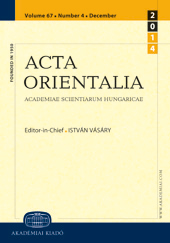Runiform fragments of the late Avar period from Hungary
Runiform fragments of the late Avar period from Hungary
Author(s): Csaba Szalontai, Károly LászlóSubject(s): Archaeology, Theoretical Linguistics, Historical Linguistics, Philology
Published by: Akadémiai Kiadó
Keywords: runiform script; East Europe; late Avar period; archaeology; palaeography;
Summary/Abstract: Although the East Old Turkic runiform inscriptions were deciphered already in 1893 by Thomsen (1896), the East European runiform fragments still present a mystery: we do not exactly know whom they belong to, which language(s) they represent, etc. During the last hundred years several attempts have been made to decipher them but nobody could provide a widely acceptable interpretation. This is because of the very nature of the findings: they are few in number and short in length. Accordingly, there is a consensus among the competent scholars that the decipherment raises serious difficulties which cannot be solved for the time being. It is, however, our primary task to document and catalogue every new finding as precisely as possible in the hope that the decipherment will one day be possible. The present article will document and analyze hitherto unknown runiform inscriptions carved into two bone plates for the grip of a bow found in a late Avar cemetery at Kiskundorozsma in South-East Hungary. The article is divided into two parts: first, an archaeological analysis with radiocarbon and thermoluminescence dating, second, a palaeographical analysis with the emphasis on methodology.
Journal: Acta Orientalia Academiae Scientiarum Hungaricae
- Issue Year: 66/2013
- Issue No: 4
- Page Range: 365-396
- Page Count: 32
- Language: English
- Content File-PDF

